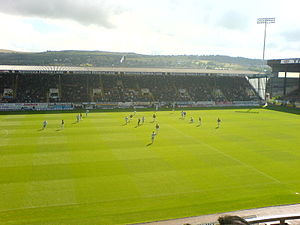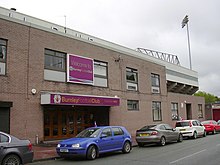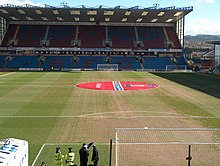Turf Moor
| Turf Moor | |
|---|---|
| The Turf | |

|
|
| The Bob Lord stand on Turf Moor in Burnley | |
| Data | |
| place | Harry Potts Way Burnley BB10 4BX, Lancashire , United Kingdom |
| Coordinates | 53 ° 47 '21 " N , 2 ° 13' 49" W |
| owner | Burnley FC |
| opening | February 17, 1883 |
| First game | 17 February 1883 Burnley FC - Rawtenstall Athletic 3-6 |
| surface |
Natural grass with artificial grass fibers (Desso GrassMaster) |
| capacity | 22,546 seats |
| playing area | 105 m × 67 m |
| Societies) | |
| Events | |
|
|
The Turf Moor (nickname: The Turf ) is a football stadium in the English town of Burnley , Lancashire . The sports facility to the east of the city center was opened on February 17, 1883 with the match between Burnley FC and Rawtenstall Athletic FC (3: 6), making it the second oldest stadium in England that the same football club used for the same football club after Deepdale , the home of Preston North End . The football club FC Burnley (nickname: The Clarets , German Die Weinroten ) plays its home games here. It currently offers 22,546 covered seats in the four tiers.
history
The beginnings
Turf Moor has been used as a sports facility since 1833. The Burnley Cricket Club played its games here. From 1840 the site also served as a horse racing track . After the establishment of Burnley Rovers FC in 1882, the club dropped the name Rovers in the following year ; moved from the old Calder Vale venue at the invitation of the cricket club and played his first game on Turf Moor in February of that year . Burnley FC and the Burnley Cricket Club have remained neighbors to this day and cooperate with each other.
The first wooden main grandstand was built in September 1884 and offered 800 seats. With the natural grandstands, it held around 2,000 spectators. In addition, two standing room tiers with 5,000 seats were built on the back door sides. The decision to build came after 12,000 spectators came to the local derby against FC Padiham (2: 4) in March 1884 . That was three times as many spectators as there were at the FA Cup final of the year. In October 1886 a member of the British royal family , Prince Albert Victor , visited an English football stadium with the Turf for the first time . Prince Albert Victor left the stadium at half time and Burnley lost 3-4 to the Bolton Wanderers . The first Football League game at the stadium was won 4-1 by Burnley FC against Bolton Wanderers on October 6, 1888. After the dissolution of Burnley Union Star FC in 1891, Burnley FC bought the main stand and their venue and placed the Star stand on the north side of the stadium. In March of that year, Burnley FC hosted Nelson FC for their first floodlit match on Turf Moor; The playing field was illuminated with 16 creosote lamps. The match ended 4-2 for the hosts in front of 3,000 spectators.
First successes
In 1898 the old Star Stand was replaced by a larger audience. A second grandstand was built five years later; in which u. a. the club offices were housed and in September of that year to accommodate the first general meeting of the club. For the FA Cup game of the fourth round on March 10, 1909 against Manchester United (2: 3), the Star Stand was expanded with turnstiles and breakwaters for 600 pounds . In 1911 the Brunshaw Road Stand (now Bob Lord Stand ) was built; which then cost £ 5,000 . It offered space for 5,500 visitors; including 2,200 seats. This increased the stadium capacity to almost 41,000 spectators. In 1913, after only 15 years , the Star Stand was demolished and rebuilt, and the Brunshaw Road Stand was extended to the entire length of the square. In addition, the cricket field stand was given a roof the following year . With the extensions, the stadium now offered around 50,000 seats; which were regularly filled. There were more people than Burnley then had. 1914 paved four home victories in the Turf against FC South Shields, Derby County , the Bolton Wanderers the AFC Sunderland the way to the semifinals of the FA Cup against Sheffield United and beyond to the final in Crystal Palace against Liverpool . Burnley FC celebrated their only final victory in the FA Cup to date with a 1-0 win on April 25, 1914.
In 1921 Burnley FC celebrated its first English championship. On the last day of the Football League First Division 1920/21 they parted on May 7, 1921 in front of their own audience from AFC Sunderland with 2-2 goals. A year later, a semi-final of the FA Cup, which, like the final, will be played on a neutral pitch, made the first and only stop on Turf Moor. The 46,000 spectators saw a 3-1 victory for eventual cup winners Huddersfield Town against Notts County . Because the pitch was too short for the semifinals; it had to be extended by 4 yards to 115 yards. The old state was restored for the next game. Two years later came the FA Cup game of the third round between Burnley FC and Huddersfield Town on February 23, 1924, the record number of 54,755 spectators in the stadium. The only international match of the English national football team in the history of the stadium was played on November 28, 1927 against Wales . The hosts lost the British Home Championship game with 1: 2 goals. At the end of the 1930s, further construction work was planned; but which became obsolete due to the Second World War .
After the Second World War
The stadium's development continued in 1954 when the Longside grandstand was completed with the help of youth players from Burnley FC. The cost of construction for the covered standing room was £ 20,000. Three years later the system received its first permanently installed floodlight system ; which was inaugurated at the game against local rivals Blackburn Rovers on December 6, 1957. It was used until the mid-1970s and replaced by a new system. After winning the second English championship of the Football League First Division in 1960, the first European Cup game was celebrated in Turf Moor on November 16 of that year . Burnley FC received the French representative Stade Reims ; it ended with a 2-0 win for the home side. After a 2: 3 in the second leg, the club met Hamburger SV in the quarter-finals . Despite a 3-1 home win on January 18, 1961; eliminated the team by a 1: 4 on March 15th in Hamburg .
In 1969 the new construction of the Cricket Field End (today: David Fishwick Stand ) was officially inaugurated by the Lord Lieutenant of Lancashire after two years of construction. The new building, built for £ 180,000, housed the changing rooms just behind the goal as well as a players tunnel. The formerly modern tier was the first stadium in England to have heated seats for the spectators. It consisted of an oil heater that conducted the warm air to the individual places via long pipes. However, due to high costs, this was ended after two years. The renovation of the stadium continued with the new construction of the Bob Lord Stand with over 2,500 seats. The £ 450,000 structure was opened in 1974 by ex-Prime Minister Edward Heath . Furthermore, a drainage system and turf heating were installed under the playing field that year.
From the mid-1970s to the mid-1980s, Burnley FC went from the Football League First Division down to the Football League Fourth Division, and so little was happening at the Clarets' venue at the time . On May 13, 1983, the game of the U-18 European Football Championship between Czechoslovakia and the Federal Republic of Germany of the U-18 European Football Championship took place in Turf Moor. The German team was defeated 3-1 by the Czechoslovaks.
From the 1990s until today
The club slowly recovered and played again in the Football League First Division in the 1994/95 season . In December 1994, the decision was made to demolish the main grandstand and a rear grandstand and replace them with two two-story grandstands according to the specifications of the Taylor Report . After the contracts with the construction company Linpave Building were signed in July 1995 ; the last game before the old main rank against Hull City (2-1) took place on September 16 . On April 23, 1996, the new main stand called the James Hargreaves Stand was inaugurated for the game against the Bristol Rovers . One day later, the demolition work began on the east strand; in September 1996, the Jimmy McIlroy spectator stand was completed. The grandstand was named after former Burnley FC player Jimmy McIlroy and opened to the public for the first time during a game against Blackpool FC . The cost of the two new builds was £ 5.3 million. A total of 42 spaces are available for wheelchair users; 22 for home fans and 20 for away fans.
On September 4, 2003, England's women's national soccer team made its debut at Burnley Stadium. The English women beat Australia 1-0 in a friendly. For the 2010/11 season, a new lawn made of a mixture of natural and artificial turf fibers was laid in the stadium . In the natural grass, around 20 million artificial fibers were inserted 20 centimeters into the ground. Over time, they intertwine to form a resilient playing surface. The new lawn also installed a new irrigation system and underfloor heating for a total of £ 750,000.
future
In July 2007 Burnley FC announced plans to renovate the stadium further for £ 20 million. Plans call for a new construction of the David Fishwick stand with 2,500 seats for £ 10 million. This includes a hotel, restaurant, business center and a cricket pavilion for the Burnley Cricket Club. This is to be used to modernize the Bob Lord stand for £ 3.75 million with VIP boxes, a cinema, restaurants and club offices. New changing rooms and boxes are to be built between the James Hargreaves stand and Jimmy McIlroy stand . New shops as well as a club bar and restaurant for home fans are on the agenda. A football school for young players is to be built on the training ground at Gawthorpe Hall . The entire project is divided into 6 phases and is to be implemented in 3 years of construction.
In April 2008, Burnley City Council unanimously approved the Turf Moor remodeling plans. In October 2008, the association had to stop the construction plans for the time being because of the global financial crisis and postpone them to a later date. Promotion to the Premier League in 2009/10 with one-season relegation left a record £ 11.7m loss in the club's coffers. As soon as the financial situation for the association has improved, the construction project should be resumed.
Grandstands
-
James Hargreaves booth - 8,154 seats
- The main grandstand on the north side, newly built in 1996, has a two-story design with lower and upper tiers. On it are u. a. 32 VIP boxes with 10 seats each and their own balcony as well as conference and event rooms. The new building replaced the popular longside stand .
-
Bob Lord Stand - 3,987 seats
- The opposite stand in the south is the flattest of the four tiers and was named after the former club chairman Bob Lord, who ran the club from 1955 to 1981. The construction was partially financed in 1974 by the sale of playmaker Martin Dobson to Everton FC .
-
Jimmy McIlroy booth - 6,280 seats
- The east stand, also built in 1996, bears the name of the former Burnley star Jimmy McIlroy and replaced the Bee Hole End . McIlroy played a total of 439 games between 1950 and 1962, scoring 116 goals for Burnley. The grandstand is visually identical to the main tier and also contains modern boxes and dining areas . The family stand is located on the upper tier, the area for families.
-
David Fishwick booth - 4,125 seats
- The back gate Cricket Field End in the west, inaugurated in 1969 , has been sponsored by the David Fishwick Stand since 2004, after a car dealer for minibuses and wheelchair-accessible minibuses. Guest fans will find around 2,100 seats on it.
Visitor record and average attendance
The highest number of spectators was on February 23, 1924 in Turf Moor. The game of the 3rd round of the 1923/24 FA Cup between Burnley FC and Huddersfield Town drew 54,775 fans to the stadium. The attendance record in times of modern seating stadiums was set on March 4, 2000 at the top game of the Football League Second Division 1999/2000 between Burnley FC and Preston North End with 22,310 visitors.
- 2014/15: 19,131 ( Premier League )
- 2015/16: 16,709 ( Football League Championship )
- 2016/17: 20,558 (Premier League)
Panorama picture
literature
- Duncan Adams: The Essential Football Fan: The Definitive Guide to Premier and Football League Grounds . Aesculus Press Limited, 2004, ISBN 978-1-904328-22-3 .
- Ray Simpson: The Clarets Chronicles: The Definitive History of Burnley Football Club 1882-2007 . Burnley FC, 2007, ISBN 978-0-9557468-0-2 .
- Simon Inglis: Football Grounds Of Britain . HarperCollins Publishers Ltd., 1996, ISBN 978-0-00-218426-7 .
Web links
- Club and stadium history on the site of FC Burnley (English)
- Visit to Turf Moor - The ravages of time , 11freunde.de, article from February 26, 2008
- Stadium data , footballgroundguide.com (English)
- History of Turf Moor , claretsmuseum.com (English)
- Detailed picture gallery , stadionwelt.de
- Visitor report from 2005 , groundhopping.de
Individual evidence
- ↑ a b c d e f The Turf Moor Story ( Memento from January 1, 2012 in the Internet Archive ) (English)
- ↑ a b c Turf Moor (1882) ( memento from January 29, 2013 in the web archive archive.today ), footballysm.moonfruit.com (English)
- ^ First game day of the 1888/89 season , fussballdaten.de
- ↑ a b c d e f Visit to Turf Moor - Der Zahn der Zeit , 11freunde.de, article from February 26, 2008
- ↑ Results of the FA Cup 1913/14 , rsssf.com (English)
- ↑ Last day of the season 1920/21 , fussballdaten.de
- ↑ a b c The History Of Turf Moor , claretsmuseum.com (English)
- ↑ picture of Longside -Tribüne ( Memento of the original on 13 September 2011 at the Internet Archive ) Info: The archive link is automatically inserted and not yet tested. Please check the original and archive link according to the instructions and then remove this notice. , oldgrounds.co.uk (English)
- ↑ Interview and portrait by Jimmy McIlroy , bbc.co.uk, article from October 7, 1996 (English)
- ↑ England win 1-0 against Australia , telegraph.co.uk, article from September 7, 2003 (English)
- ↑ New lawn laid in Turf Moor , clarets-mad.co.uk, article from May 24, 2010 (English)
- ↑ Reconstruction plans for Turf Moor presented , lancashiretelegraph.co.uk, article from July 23, 2007 (English)
- ↑ City council approves renovation plans , lancashiretelegraph.co.uk, April 3, 2008 article
- ↑ Plans put on hold for the time being , thisislancashire.co.uk, article from October 8, 2008 (English)
- ↑ Burnley FC announces record loss , burnleyexpress.net, article from November 20, 2009 (English)
- ↑ Interview with club chairman Barry Kilby , lancashiretelegraph.co.uk, article from November 25, 2009
- ↑ VIP boxes and event rooms ( Memento of the original from September 24, 2010 in the Internet Archive ) Info: The archive link was inserted automatically and has not yet been checked. Please check the original and archive link according to the instructions and then remove this notice. , claretscorporate.com (English)
- ↑ Portrait of the long-time club chairman Bob Lord (1955–1981) , clarets-mad.co.uk, article from December 8, 2001 (English)
- ↑ a b Turf Moor - Home of Burnley FC ( Memento from October 17, 2009 in the Internet Archive ) (English)
- ↑ Interview and portrait by Jimmy McIlroy , bbc.co.uk, article from October 7, 1996 (English)
- ↑ Sponsorship agreement for Fishwick stand extended , lancashiretelegraph.co.uk, article from February 10, 2009 (English)
- ↑ Record attendance and average attendance , footballgroundguide.com (English)




